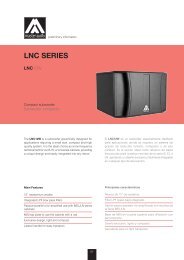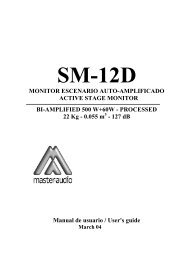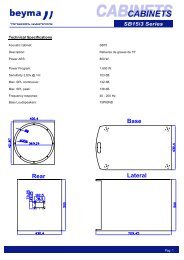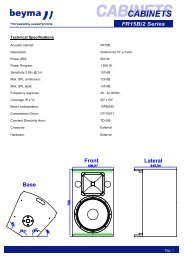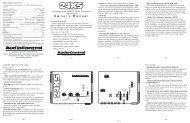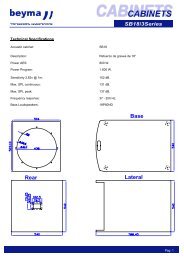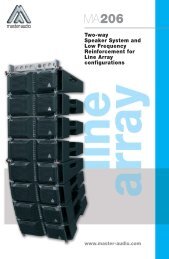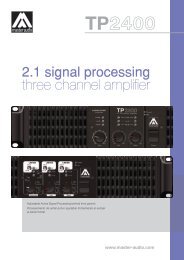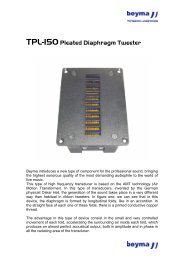NT SERIES
NT SERIES
NT SERIES
Create successful ePaper yourself
Turn your PDF publications into a flip-book with our unique Google optimized e-Paper software.
<strong>NT</strong> <strong>SERIES</strong><br />
<strong>NT</strong>12P / <strong>NT</strong>15P<br />
<strong>NT</strong>12N / <strong>NT</strong>15N<br />
<strong>NT</strong>12A250 / <strong>NT</strong>15A250<br />
<strong>NT</strong>12A500 / <strong>NT</strong>15A500<br />
Dic2008 / Dec2008<br />
Pol.Ind.Norte-Perpinyà,25<br />
08226 TERRASSA (Barcelona-SPAIN)<br />
info@master-audio.com<br />
www.master-audio.com
Amate Electroacústica,s.l.<br />
ESPAÑOL<br />
CAUTION<br />
RISK OF ELECTRIC SHOCK<br />
DON’T OPEN<br />
Instrucciones de seguridad<br />
1. Todas las instrucciones de seguridad deben ser leídas antes de utilizar este<br />
aparato.<br />
2. El signo de exclamación dentro de un triángulo indica componentes internos cuyo<br />
reemplazo puede afectar la seguridad.<br />
3. El símbolo del rayo con la punta de la flecha indica la presencia de voltajes<br />
peligrosos no aislados.<br />
4. Este equipo no debe ser expuesto a la lluvia ni a la humedad. No lo use, por<br />
ejemplo, cerca de piscinas, fuentes o cualquier lugar donde pueda ser afectado por<br />
líquidos.<br />
5. Limpie el aparato sólo con paños secos.<br />
6. No sitúe el equipo en lugares donde se interfiera la ventilación del aparato.<br />
7. No instale el aparato cerca de ninguna fuente de calor, como radiadores, estufas u<br />
otros aparatos que emitan calor.<br />
8. Este equipo debe ser reparado por personal cualificado del servicio técnico<br />
cuando:<br />
A. El cable de red esté dañado, o<br />
B. Algún objeto o liquido haya dañado el aparato; o<br />
C. El equipo no funcione de una manera normal (correcta); o<br />
D. El equipo se haya expuesto a la lluvia; o<br />
E. El chasis esté dañado<br />
9. Desconecte el aparato en caso de tormentas eléctricas o cuando no vaya a<br />
emplearlo durante largos períodos de tiempo.<br />
10. No cuelgue el equipo por el asa.<br />
WARNING:<br />
To reduce the risk of fire or electric shock do<br />
not expose this equipment to rain or moisture<br />
11. Use sólo accesorios recomendados por el fabricante.<br />
<strong>NT</strong> Series.Version 1.2 Dec08 2
Amate Electroacústica,s.l.<br />
1.I<strong>NT</strong>RODUCCIÓN<br />
1.1. Generalidades<br />
Amate Electroacústica, s.l. le agradece la confianza depositada en nuestros<br />
productos de la Serie <strong>NT</strong>. Le sugerimos lea atentamente las indicaciones que a<br />
continuación exponemos, confiando en que le serán de gran utilidad para obtener<br />
sus mejores resultados.<br />
1.2. Características y presentación<br />
<strong>NT</strong>-12P<br />
- Sistema de 2 vías Full Range.<br />
- Incorpora filtro divisor pasivo diseñado con precisión para obtener los mejores<br />
resultados.<br />
- Altavoz de 12" y alto rendimiento.<br />
- Motor de agudos con diafragma de Titanio de 1" ½.<br />
- Capacidad de Potencia de 250W r.m.s<br />
- Sensibilidad de 98 dB (1W/1m).<br />
<strong>NT</strong>-12N<br />
- Sistema de 2 vías Full Range.<br />
- Incorpora filtro divisor pasivo diseñado con precisión para obtener los mejores<br />
resultados.<br />
- Altavoz de 12" de Neodimio y alto rendimiento.<br />
- Motor de agudos con diafragma de Titanio de 1" ½.<br />
- Capacidad de Potencia de 350W r.m.s<br />
- Sensibilidad de 98 dB (1W/1m).<br />
<strong>NT</strong>-15P<br />
- Sistema de 2 vías Full Range.<br />
- Incorpora filtro divisor pasivo diseñado con precisión para obtener los mejores<br />
resultados.<br />
- Altavoz de 15" y alto rendimiento.<br />
- Motor de agudos con diafragma de Titanio de 1" ½.<br />
- Capacidad de Potencia de 250W r.m.s<br />
- Sensibilidad de 99 dB (1W/1m).<br />
<strong>NT</strong>-15N<br />
- Sistema de 2 vías Full Range.<br />
- Incorpora filtro divisor pasivo diseñado con precisión para obtener los mejores<br />
resultados.<br />
- Altavoz de 15" de Neodimio y alto rendimiento.<br />
- Motor de agudos con diafragma de Titanio de 1" ½.<br />
- Capacidad de Potencia de 400W r.m.s<br />
- Sensibilidad de 99 dB (1W/1m).<br />
<strong>NT</strong> Series.Version 1.2 Dec08 3
Amate Electroacústica,s.l.<br />
<strong>NT</strong>-12A250<br />
- Entrada balanceada electrónicamente (XLR).<br />
- Salida paralela con conector XLR.<br />
- Divisor Activo de 24 dB/Oct.<br />
- Amplificador Clase D de 200 W.<br />
- Altavoz de 12" de alto rendimiento.<br />
- Amplificador de Clase AB de 50 W.<br />
- Motor de agudos con diafragma de Titanio de 1" ½.<br />
- Total procesamiento de señal con limitadores de clipping.<br />
<strong>NT</strong>-12A500<br />
- Entrada balanceada electrónicamente (XLR).<br />
- Salida paralela con conector XLR.<br />
- Divisor Activo de 24 dB/Oct.<br />
- Amplificador Clase D de 500 W.<br />
- Altavoz de 12" de Neodimio y alto rendimiento.<br />
- Amplificador de Clase AB de 60 W.<br />
- Motor de agudos con diafragma de Titanio de 1" ½.<br />
- Total procesamiento de señal con limitadores de clipping.<br />
<strong>NT</strong>-15A250<br />
- Entrada balanceada electrónicamente (XLR).<br />
- Salida paralela con conector XLR.<br />
- Divisor Activo de 24 dB/Oct.<br />
- Amplificador Clase D de 200 W.<br />
- Altavoz de 15" de alto rendimiento.<br />
- Amplificador de Clase AB de 50 W.<br />
- Motor de agudos con diafragma de Titanio de 1" ½.<br />
- Total procesamiento de señal con limitadores de clipping.<br />
<strong>NT</strong>-15A500<br />
- Entrada balanceada electrónicamente (XLR).<br />
- Salida paralela con conector XLR.<br />
- Divisor Activo de 24 dB/Oct.<br />
- Amplificador Clase D de 500 W.<br />
- Altavoz de 15" de Neodimio y alto rendimiento.<br />
- Amplificador de Clase AB de 60 W.<br />
- Motor de agudos con diafragma de Titanio de 1" ½.<br />
- Total procesamiento de señal con limitadores de clipping.<br />
<strong>NT</strong> Series.Version 1.2 Dec08 4
Amate Electroacústica,s.l.<br />
2.CONEXIONES <strong>NT</strong>12A250 / <strong>NT</strong>12A500 / <strong>NT</strong>15A250 / <strong>NT</strong>15A500<br />
Fig.1. Panel de conexiones<br />
1 4<br />
2<br />
3<br />
5 6<br />
1-GAIN: Ajusta el nivel de entrada.<br />
2-INPUT: Conector XLR de señal balanceada:<br />
1= Shield 2= Live 3=Return<br />
3-LINK: Conector XLR para conectar en paralelo varias cajas con la misma señal<br />
de entrada.<br />
1= Shield 2= Live 3= Return<br />
4-LIMITER: Evita que las salidas del amplificador saturen a los transductores.<br />
Cuando alguno de los LEDS de LIMITER se activa, pasa a color rojo. Los<br />
indicadores pueden estar en color rojo ocasionalmente, pero si lo están<br />
continuamente, baje el nivel de control hasta que lo estén solamente de una manera<br />
ocasional.<br />
5-MAINS SUPPLY(I): Base para conexión de red AC.<br />
6-MAINS SUPPLY(II): Encendido /apagado del aparato.<br />
<strong>NT</strong> Series.Version 1.2 Dec08 5
Amate Electroacústica,s.l.<br />
CONEXIONES <strong>NT</strong>12P / <strong>NT</strong>12N / <strong>NT</strong>15P / <strong>NT</strong>15N<br />
Fig.2. Panel de conexiones<br />
1-SPEAKON : Los cuatro modelos incorporan terminales Speakon y están<br />
preparados para su perfecta conexión en un sistema en paralelo.<br />
Pin +1 : Positivo<br />
Pin -1 : Negativo<br />
ATENCIÓN: Utilice en lo posible cable-manguera de dos conductores, sin apantallar,<br />
bicolor y de buena calidad. Se recomienda el uso de una sección de 4mm 2 como<br />
mínimo para cada conductor.<br />
Evítese en lo posible largas distancias de cableado ya que provocan importantes<br />
pérdidas de potencia y calidad<br />
<strong>NT</strong> Series.Version 1.2 Dec08 6<br />
1<br />
1
Amate Electroacústica,s.l.<br />
2.1. Configuraciones<br />
2.1.1. Conexión "daisy chaining" (modelos Activos)<br />
Se pueden conectar las unidades requeridas a través de una configuración Daisy-<br />
Chaining. Conecte la señal (salida de mesa de mezclas) a la entrada INPUT de la<br />
primera unidad. Usar la salida LINK (primera unidad) para transportar la señal a la<br />
entrada INPUT de la segunda unidad y así sucesivamente.<br />
Fig.3. Configuración “daisy chaining”<br />
2.1.2.Conexión a un subwoofer pasivo (modelos Activos)<br />
Conectar la señal (salida de mesa de mezclas) a la entrada INPUT de la caja Full<br />
Range y usar la salida LINK para transportar la señal al módulo amplificador externo<br />
que alimentará el subwoofer pasivo.<br />
Fig.4. Conexión a un subwoofer pasivo<br />
<strong>NT</strong> Series.Version 1.2 Dec08 7
Amate Electroacústica,s.l.<br />
2.1.3. Conexión a un subwoofer activo (Modelos Activos)<br />
Conectar la señal (salida de mesa de mezclas) a la entrada INPUT de la caja Full<br />
Range y usar la salida LINK para transportar la señal a la entrada INPUT del<br />
subwoofer activo.<br />
Se pueden ajustar los niveles de la caja Full Range y del subwoofer a través de los<br />
potenciómetros de Gain.<br />
Fig.5. Conexión a un subwoofer activo<br />
2.1.4. Configuración Stereo (modelos Pasivos)<br />
Conectar la salida del amplificador LEFT a una de las unidades. Conectar la salida<br />
del amplificador RIGHT a la segunda unidad.<br />
En caso de cajas activas conectar directamente las salidas de la mesa de mezclas a<br />
las cajas.<br />
Fig.6. Configuración stereo<br />
<strong>NT</strong> Series.Version 1.2 Dec08 8
Amate Electroacústica,s.l.<br />
2.1.5.Configuración en Pasivo con Subwoofer (modelos Pasivos)<br />
En este caso se dispondrá de un sólo amplificador para todo el sistema.<br />
De una de las salidas del amplificador conectar, mediante cable manguera, la unidad<br />
de graves.<br />
Posteriormente, efectuar un puente desde el conector Speakon esclavo del<br />
subwoofer a su respectiva unidad satélite de medios-agudos, respetando siempre la<br />
correcta polaridad entre ambos sistemas. Proceder de igual manera para el otro<br />
canal.<br />
También es correcto, si la instalación lo requiere, efectuar la conexión a la inversa,<br />
es decir, del amplificador al satélite y luego al subwoofer.<br />
Fig.7. Configuración en pasivo con subwoofer<br />
2.1.6.Configuración Bi-Amplificada con Subwoofer (Modelos pasivos)<br />
Del canal de salida de la etapa de potencia destinada a graves saldremos con una<br />
manguera de la mayor sección posible (4mm 2 mínimo) hacia uno de los subwoofers.<br />
Si se dispone de pareja de subwoofers, realizaremos una conexión en puente entre<br />
ambos, respetando siempre la polaridad.<br />
Conectar la otra salida del amplificador independientemente a la caja de mediosagudos.<br />
También es posible destinar un sólo amplificador para los refuerzos de graves,<br />
conectando cada uno de los subwoofers a las dos salidas de la etapa y en<br />
consecuencia, alimentar el sistema de medios-agudos mediante un segundo<br />
amplificador.<br />
Fig.8. Configuración bi-amplificada con subwoofer (opción 1)<br />
<strong>NT</strong> Series.Version 1.2 Dec08 9
Amate Electroacústica,s.l.<br />
Fig.9. Configuración bi-amplificada con subwoofer (opción 2)<br />
3.MO<strong>NT</strong>AJE E INSTALACIÓN<br />
Para la adecuada instalación de los sistemas de cajas acústicas se recomienda lea<br />
atentamente los siguientes consejos.<br />
3.1. Posicionamiento<br />
Coloque las unidades "Full Range" siempre que sea posible en posición elevada<br />
(entre dos y tres metros del suelo), ligeramente inclinadas hacia la audiencia. Si las<br />
cajas se colocan a una altura cercana al suelo los oyentes de las últimas filas<br />
recibirán un sonido de baja calidad.<br />
Fig.10. Posicionamiento en formato volado<br />
Pueden situarse juntas, dos a dos, en forma de clúster, una al lado de la otra,<br />
aprovechando su formato trapezoidal, o bien una encima de la otra procurando<br />
siempre esa ligera orientación inclinada que garantice la mejor cobertura horizontal y<br />
vertical.<br />
Para posicionar las unidades de graves, es recomendable que éstas sean colocadas<br />
en el mismo suelo ya que así se produce el llamado "efecto-suelo" que incrementa la<br />
respuesta en bajas frecuencias.<br />
Le aconsejamos coloque, siempre que sea posible, las unidades de graves bajo el<br />
mismo eje acústico de dónde estén ubicados los satélites.<br />
Si esto no es posible deberían situarse en un punto intermedio entre los canales<br />
Izquierdo y Derecho.<br />
<strong>NT</strong> Series.Version 1.2 Dec08 10
Amate Electroacústica,s.l.<br />
3.2. Uso con trípode<br />
Todos los modelos incorporan en su parte inferior un vaso para trípode Standard de<br />
35mm.<br />
No utilice el trípode en superficies con pendiente ni coloque las cajas demasiado<br />
altas, pues el sistema puede ser totalmente inestable.<br />
3.3. Uso como monitor<br />
La forma trapezoidal de todos los modelos permite su utilización como monitor de<br />
escenario sin la necesidad de incorporar ningún accesorio extra.<br />
3.4. Giro del logotipo<br />
Los logotipos de los modelos pueden girarse.<br />
3.5. Volado<br />
Sólo personal especializado debe realizar el volado de sistemas acústicos.<br />
Asegúrese del peso que es capaz de soportar la estructura sobre la cual se va a<br />
colgar la caja.<br />
El hardware de volado (cadenas, pasadores, anillas...) debe ser revisado<br />
regularmente y, en caso de cualquier duda, debe ser reemplazado por material<br />
nuevo.¡ATENCIÓN!!! ¡NO COLGAR NUNCA LAS CAJAS POR EL ASA!!!!<br />
Todos los recintos disponen de 4 puntos de suspensión M10, en el sobre, parte<br />
inferior y partes laterales. Adicionalmente, el punto M8 donde se encuentra el pomo<br />
para fijar la caja al trípode puede ser utilizado para dar la inclinación necesaria. Su<br />
correcta combinación permite el volado de las cajas tanto en posición horizontal<br />
como en vertical.<br />
Fig.11.Puntos de volado<br />
1<br />
3 4<br />
<strong>NT</strong> Series.Version 1.2 Dec08 11<br />
5<br />
2
Amate Electroacústica,s.l.<br />
Volado horizontal<br />
Puntos 1 y 2. Utilice el punto 3 o 4 para dar la inclinación necesaria.<br />
Volado vertical<br />
Puntos 3 y 4. Utilice el punto 5 para dar la inclinación necesaria.<br />
Como accesorio opcional de volado se suministran anillas Rigging de M10 (ACR<br />
M10)<br />
4. ESPECIFICACIONES<br />
4.1. Especificaciones <strong>NT</strong>-12P<br />
Impedancia 8Ω<br />
Sensibilidad 1W/1m 98dB<br />
Respuesta en frecuencia (-10 dB) 55Hz-20kHz<br />
Capacidad de potencia<br />
R.M.S 250W<br />
Programa 500W<br />
Directividad nominal (-6dB)<br />
Horizontal 110º<br />
Vertical 70º<br />
Componentes<br />
LF 1x12" woofer<br />
HF 1x motor con diafragma de titanio (bobina 1.5”)<br />
Recinto<br />
Altura 591mm<br />
Anchura 380 mm<br />
Profundidad 358 mm<br />
Peso (neto) 15,1Kg<br />
Conectores 2 x Speakon (IN/LINK)<br />
Material Fibras plásticas técnicas, Reja frontal de acero pintada epoxy<br />
negra<br />
Acabado Color negro<br />
4.2. Especificaciones <strong>NT</strong>-12N<br />
Impedancia 8Ω<br />
Sensibilidad 1W/1m 98dB<br />
Respuesta en frecuencia (-10 dB) 55Hz-20kHz<br />
<strong>NT</strong> Series.Version 1.2 Dec08 12
Amate Electroacústica,s.l.<br />
Capacidad de potencia<br />
R.M.S 350W<br />
Programa 700W<br />
Directividad nominal (-6dB)<br />
Horizontal 110º<br />
Vertical 70º<br />
Componentes<br />
LF 1x12" woofer neodimio<br />
HF 1x motor con diafragma de titanio (bobina 1.5”)<br />
Recinto<br />
Altura 591mm<br />
Anchura 380 mm<br />
Profundidad 358 mm<br />
Peso (neto) 13,5Kg<br />
Conectores 2 x Speakon (IN/LINK)<br />
Material Fibras plásticas técnicas, Reja frontal de acero pintada epoxy<br />
negra<br />
Acabado Color negro<br />
4.3. Especificaciones <strong>NT</strong>-15P<br />
Impedancia 8Ω<br />
Sensibilidad 1W/1m 99dB<br />
Respuesta en frecuencia (-10 dB) 50Hz-20kHz<br />
Capacidad de potencia<br />
R.M.S 250W<br />
Programa 500W<br />
Directividad nominal (-6dB)<br />
Horizontal 110º<br />
Vertical 70º<br />
Componentes<br />
LF 1x15" woofer<br />
HF 1x motor con diafragma de titanio (bobina 1.5”)<br />
Recinto<br />
Altura 700mm<br />
Anchura 445 mm<br />
Profundidad 406 mm<br />
Peso (neto) 18,8Kg<br />
Conectores 2 x Speakon (IN/LINK)<br />
Material Fibras plásticas técnicas, Reja frontal de acero pintada epoxy<br />
negra<br />
Acabado Color negro<br />
<strong>NT</strong> Series.Version 1.2 Dec08 13
Amate Electroacústica,s.l.<br />
4.4. Especificaciones <strong>NT</strong>-15N<br />
Impedancia 8Ω<br />
Sensibilidad 1W/1m 99dB<br />
Respuesta en frecuencia (-10 dB) 50Hz-20kHz<br />
Capacidad de potencia<br />
R.M.S 400W<br />
Programa 800W<br />
Directividad nominal (-6dB)<br />
Horizontal 110º<br />
Vertical 70º<br />
Componentes<br />
LF 1x15" woofer neodimio<br />
HF 1x motor con diafragma de titanio (bobina 1.5”)<br />
Recinto<br />
Altura 700mm<br />
Anchura 445 mm<br />
Profundidad 406 mm<br />
Peso (neto) 17,9Kg<br />
Conectores 2 x Speakon (IN/LINK)<br />
Material Fibras plásticas técnicas, Reja frontal de acero pintada epoxy<br />
negra<br />
Acabado Color negro<br />
4.5. Especificaciones <strong>NT</strong>-12A250<br />
Entrada de línea 1.5V/10kΩ<br />
Alimentación 230V +/-10%<br />
Consumo a máx. potencia
Amate Electroacústica,s.l.<br />
Recinto<br />
Altura 591mm<br />
Anchura 380 mm<br />
Profundidad 358 mm<br />
Peso (neto) 15,9Kg<br />
Conectores 2 x XLR (IN/LINK), AC INPUT<br />
Material Fibras plásticas técnicas, Reja frontal de acero pintada epoxy<br />
negra<br />
Acabado Color negro<br />
4.6. Especificaciones <strong>NT</strong>-12A500<br />
Entrada de línea 1.5V/10kΩ<br />
Alimentación 230V +/-10%<br />
Consumo a máx. potencia 3A<br />
Máximo SPL 125dB<br />
Respuesta en frecuencia (-10 dB) 55Hz-20kHz<br />
Directividad nominal (-6dB)<br />
Horizontal 110º<br />
Vertical 70º<br />
Componentes<br />
LF 1x12" woofer neodimio<br />
HF 1x motor con diafragma de titanio (bobina 1.5”)<br />
Recinto<br />
Altura 591mm<br />
Anchura 380 mm<br />
Profundidad 358 mm<br />
Peso (neto) 16,2Kg<br />
Conectores 2 x XLR (IN/LINK), AC INPUT<br />
Material Fibras plásticas técnicas, Reja frontal de acero pintada epoxy<br />
negra<br />
Acabado Color negro<br />
4.7. Especificaciones <strong>NT</strong>-15A250<br />
Entrada de línea 1.5V/10kΩ<br />
Alimentación 230V +/-10%<br />
Consumo a máx. potencia
Amate Electroacústica,s.l.<br />
Directividad nominal (-6dB)<br />
Horizontal 110º<br />
Vertical 70º<br />
Componentes<br />
LF 1x15" woofer<br />
HF 1x motor con diafragma de titanio (bobina 1.5”)<br />
Recinto<br />
Altura 700mm<br />
Anchura 445 mm<br />
Profundidad 406 mm<br />
Peso (neto) 19,5Kg<br />
Conectores 2 x XLR (IN/LINK), AC INPUT<br />
Material Fibras plásticas técnicas, Reja frontal de acero pintada epoxy<br />
negra<br />
Acabado Color negro<br />
4.8. Especificaciones <strong>NT</strong>-15A500<br />
Entrada de línea 1.5V/10kΩ<br />
Alimentación 230V +/-10%<br />
Consumo a máx. potencia 3A<br />
Máximo SPL 126dB<br />
Respuesta en frecuencia (-10 dB) 50Hz-20kHz<br />
Directividad nominal (-6dB)<br />
Horizontal 110º<br />
Vertical 70º<br />
Componentes<br />
LF 1x15" woofer neodimio<br />
HF 1x motor con diafragma de titanio (bobina 1.5”)<br />
Recinto<br />
Altura 700mm<br />
Anchura 445 mm<br />
Profundidad 406 mm<br />
Peso (neto) 19,5Kg<br />
Conectores 2 x XLR (IN/LINK), AC INPUT<br />
Material Fibras plásticas técnicas, Reja frontal de acero pintada epoxy<br />
negra<br />
Acabado Color negro<br />
<strong>NT</strong> Series.Version 1.2 Dec08 16
Amate Electroacústica,s.l.<br />
5.APÉNDICE<br />
PÉRDIDA DE POTENCIA (EN %) Y FACTOR DE DAMPING, RELATIVA A LA<br />
LONGITUD DEL CABLE Y SU SECCIÓN<br />
Largo<br />
cable<br />
(m)<br />
1<br />
5<br />
10<br />
20<br />
50<br />
Sección<br />
(mm 2 )<br />
Resistencia<br />
(Ohms)<br />
Pérdida de Potencia<br />
8Ohms 4Ohms 2Ohms<br />
Pérdida<br />
Damping(*)<br />
8Ohms 4 Ohms<br />
0.75 0.042 0.53% 1.05% 2.10% 98 49<br />
1.50 0.025 0.31% 0.63% 1.25% 123 62<br />
2.50 0.013 0.16% 0.33% 0.65% 151 75<br />
4.00 0.008 0.10% 0.20% 0.40% 167 83<br />
0.75 0.210 2.63% 5.25% 10.5% 32 16<br />
1.50 0.125 1.56% 3.13% 6.25% 48 24<br />
2.50 0.065 0.81% 1.63% 3.25% 76 38<br />
4.00 0.040 0.50% 1.00% 2.00% 100 50<br />
0.75 0.420 5.25% 10.50% 21.00% 17 9<br />
1.75 0.250 3.13% 6.25% 12.50% 28 14<br />
2.50 0.130 1.63% 3.25% 6.50% 47 24<br />
4.00 0.080 1.00% 2.00% 4.00% 67 33<br />
0.75 0.840 10.50% 21.00% 42.00% 9 5<br />
1.50 0.500 6.25% 12.50% 25.00% 15 7<br />
2.50 0.260 3.25% 6.50% 13.00% 27 13<br />
4.00 0.160 2.00% 4.00% 8.00% 40 20<br />
0.75 2.100 26.25% 52.50% --- 4 2<br />
1.50 1.250 15.63% 31.25% 62.50% 6 3<br />
2.50 0.650 8.13% 16.25% 32.50% 12 6<br />
4.00 0.400 5.00% 10.00% 20.00% 18 9<br />
(*) Referido a un amplificador con un Factor de Amortiguamiento de 200:1.<br />
Las secciones de cable inferiores a 2.50 mm 2 deben desconsiderarse.<br />
Para instalaciones fijas con cargas a 4 Ohms, es preferible disponer de un cable por<br />
Sistema de Altavoces. No es aconsejable "puentear" las cajas entre sí.<br />
<strong>NT</strong> Series.Version 1.2 Dec08 17
Amate Electroacústica,s.l.<br />
6.SOLUCIÓN DE PROBLEMAS<br />
Sin alimentación<br />
• Asegúrese que el aparato esté conectado a la red.<br />
• El Fusible puede estar fundido. Reemplace el fusible situado en el portafusibles<br />
por otro del mismo tipo. Si se vuelve a fundir, lleve su unidad a un centro autorizado<br />
de reparación.<br />
Sin sonido<br />
• Compruebe en el indicador de salida del mezclador que la señal está siendo<br />
enviada.<br />
• Asegúrese que el potenciómetro de VOLUME está correctamente posicionado.<br />
• Compruebe que los cables de señal estén en buenas condiciones y conectados en<br />
ambos extremos.<br />
• El nivel de salida del mezclador no debe estar al mínimo.<br />
• Revise que el mezclador no esté en Mute.<br />
Señal de salida distorsionada y LEDS de clipping activados<br />
• El sistema está siendo sobrecargado con demasiada señal de entrada y ha<br />
alcanzado la máxima potencia. Bajar el nivel de salida del mezclador o la ganancia<br />
de los canales.<br />
Nivel de graves pobre<br />
• Compruebe la polaridad de las conexiones entre el mezclador y los altavoces. Si<br />
las conexiones positivas y negativas están invertidas en un extremo del cable, puede<br />
que un altavoz esté fuera de fase.<br />
Ruidos y zumbidos<br />
• Asegúrese que todas las conexiones a las cajas auto-amplificadas están en buenas<br />
condiciones.<br />
• Evite que los cables de señal estén liados con los cables de red o cerca de<br />
transformadores o aparatos que emitan EMI.<br />
• Compruebe que no hay ningún regulador de intensidad de luz en el mismo circuito<br />
AC que la caja. Conecte el circuito de sonido y el de luces a distintas fases.<br />
<strong>NT</strong> Series.Version 1.2 Dec08 18
Amate Electroacústica,s.l.<br />
1. I<strong>NT</strong>RODUCTION<br />
1.1. General<br />
Amate Electroacústica, s.l. would like to thank you for your confidence in our <strong>NT</strong><br />
Series. We suggest you to carefully read the following instructions in order to obtain<br />
the best results in performance.<br />
1.2. Features and presentation<br />
<strong>NT</strong>-12P<br />
- Two Way Full Range Speaker System.<br />
- Passive version with an accurate designed Crossover to achieve the best<br />
performance.<br />
- 12" High Performance Woofer.<br />
- 1" ½ Titanium diaphragm Driver.<br />
- Power Handling: 250W r.m.s.<br />
- Sensitivity : 98 dB (1W/1m).<br />
<strong>NT</strong>-12N<br />
- Two Way Full Range Speaker System.<br />
- Passive version with an accurate designed Crossover to achieve the best<br />
performance.<br />
- 12" High Performance NeodymiumWoofer.<br />
- 1" ½ Titanium diaphragm Driver.<br />
- Power Handling: 350W r.m.s.<br />
- Sensitivity : 98 dB (1W/1m).<br />
<strong>NT</strong>-15P<br />
- Two Way Full Range Speaker System.<br />
- Passive version with an accurate designed Crossover to achieve the best<br />
performance.<br />
- 15" High Performance Woofer.<br />
- 1" ½ Titanium diaphragm Driver.<br />
- Power Handling: 250W r.m.s.<br />
- Sensitivity : 99 dB (1W/1m).<br />
<strong>NT</strong>-15N<br />
- Two Way Full Range Speaker System.<br />
- Passive version with an accurate designed Crossover to achieve the best<br />
performance.<br />
- 15" High Performance Neodymium Woofer.<br />
- 1" ½ Titanium diaphragm Driver.<br />
- Power Handling: 400W r.m.s.<br />
- Sensitivity : 99 dB (1W/1m).<br />
<strong>NT</strong> Series.Version 1.2 Dec08 19
Amate Electroacústica,s.l.<br />
<strong>NT</strong>-12A250<br />
- Electronically balanced Input (XLR).<br />
- XLR parallel output.<br />
- 24dB/Oct Active Crossover.<br />
- 200 W High Efficiency Class D Amplifier.<br />
- 12" High Performance Woofer.<br />
- 50 W Class AB Amplifier.<br />
- 1" ½ Titanium diaphragm Driver.<br />
- Full Signal Processing with active clip limiters.<br />
<strong>NT</strong>-12A500<br />
- Electronically balanced Input (XLR).<br />
- XLR parallel output.<br />
- 24dB/Oct Active Crossover.<br />
- 500 W High Efficiency Class D Amplifier.<br />
- 12" High Performance Neodymium Woofer.<br />
- 60 W Class AB Amplifier.<br />
- 1" ½ Titanium diaphragm Driver.<br />
- Full Signal Processing with active clip limiters.<br />
<strong>NT</strong>-15A250<br />
- Electronically balanced Input (XLR).<br />
- XLR parallel output.<br />
- 24dB/Oct Active Crossover.<br />
- 200 W High Efficiency Class D Amplifier.<br />
- 15" High Performance Woofer.<br />
- 50 W Class AB Amplifier.<br />
- 1" ½ Titanium diaphragm Driver.<br />
- Full Signal Processing with active clip limiters.<br />
<strong>NT</strong>-15A500<br />
- Electronically balanced Input (XLR).<br />
- XLR parallel output.<br />
- 24dB/Oct Active Crossover.<br />
- 500 W High Efficiency Class D Amplifier.<br />
- 15" High Performance Neodymium Woofer.<br />
- 60 W Class AB Amplifier.<br />
- 1" ½ Titanium diaphragm Driver.<br />
- Full Signal Processing with active clip limiters.<br />
<strong>NT</strong> Series.Version 1.2 Dec08 20
Amate Electroacústica,s.l.<br />
2.<strong>NT</strong>12A250 / <strong>NT</strong>12A500 / <strong>NT</strong>15A250 / <strong>NT</strong>15A500 CONNECTIONS<br />
Fig.1. Connections pannel<br />
1 4<br />
2<br />
3<br />
5 6<br />
1-GAIN: Controls the level of the LINE Input<br />
2-INPUT: Balanced signal XLR:<br />
1= Shield 2= Live 3= Return<br />
3-LINK: XLR connector used for paralleling several units, which will share the same<br />
input.<br />
1= Shield 2= Live 3= Return<br />
4-LIMITER: Prevents the amplifier outputs from overdriving the transducers. When<br />
the LIMITER indicators are active, they are in red colour. The LIMITER indicators can<br />
be in red occasionally, but if they are continuously activated, turn down the level<br />
control until the LIMITER indicators are only in red occasionally.<br />
5-MAINS SUPPLY(I): Standard male connector. Plug the mains cable here.<br />
6-MAINS SUPPLY(II): Turns the unit on or off.<br />
<strong>NT</strong> Series.Version 1.2 Dec08 21
Amate Electroacústica,s.l.<br />
<strong>NT</strong>12P / <strong>NT</strong>12N / <strong>NT</strong>15P / <strong>NT</strong>15N CONNECTIONS<br />
Fig.2. Connections pannel<br />
1-SPEAKON : All models use two Speakon terminals and are duly prepared for a<br />
perfect connection in a parallel system.<br />
Pin +1 : Positive<br />
Pin -1: Negative<br />
WARNING: It is strongly recommended to use a two-conductor high quality wire, nonshielded<br />
and two-coloured. We recommend to use a minimum section of 4mm 2 for<br />
each conductor.<br />
Avoid, if possible, long wire distances as they induce to important power and quality<br />
losses.<br />
<strong>NT</strong> Series.Version 1.2 Dec08 22<br />
1<br />
1
Amate Electroacústica,s.l.<br />
2.1. Configurations<br />
2.1.1. Daisy chaining connection (Active models)<br />
You may daisy chain as many units as required. Plug into the INPUT of the first unit<br />
(from a Mixer's output). Then connect the LINK output (first unit) to the INPUT of the<br />
second unit, and so on.<br />
Fig.3. “daisy chaining” configuration<br />
2.1.2. Connection with a passive subwoofer (Active models)<br />
Plug into the INPUT of the cabinet (from a Mixer's output) and then use the LINK<br />
output to carry the signal to the input of an amplifier, which will drive the passive<br />
subwoofer.<br />
Fig.4. Connection with passive subwoofer<br />
<strong>NT</strong> Series.Version 1.2 Dec08 23
Amate Electroacústica,s.l.<br />
2.1.3. Connection with an active subwoofer (Active models)<br />
Plug into the INPUT of the cabinet (from a Mixer's output) and then use the LINK<br />
output to carry the signal to the input of the active subwoofer.<br />
The levels of the subwoofer and the Full Range cabinet can be adjusted through the<br />
Gain potentiometer.<br />
Fig.5. Connection with active subwoofer<br />
2.1.4. Stereo configuration (passive models)<br />
Connect the LEFT output of the amplifier to the first cabinet. Connect the RIGHT<br />
output of the amplifier to the second cabinet.<br />
In case of Active cabinets, connect the mixer’s outputs to the cabinet’s inputs.<br />
Fig.6. Stereo configuration<br />
<strong>NT</strong> Series.Version 1.2 Dec08 24
Amate Electroacústica,s.l.<br />
2.1.5. Passive configuration with Subwoofer (Passive models)<br />
In this case one amplifier will be only used for the whole system.<br />
Connect one of the outputs of the amplifier to the subwoofer through a wire.<br />
Then, make a bridge from the slave Speakon connector of the subwoofer to its<br />
respective mid-high satellite unit, always respecting the correct polarity between both<br />
systems.<br />
Do the same with the other channel.<br />
It is also correct, if the installation requires so, to make the connection in the opposite<br />
way, that is, from the amplifier to the satellite and then to the subwoofer.<br />
Fig.7. Passive with subwoofer configuration<br />
2.1.6. Bi-Amplified configuration with Subwoofer (Passive models)<br />
A wire with the maximum available section (4mm 2 minimum) will have to link the low<br />
frequencies output channel of the amplifier to one of the subwoofers.<br />
Two subwoofers can be also connected by bridge one to another, as long as the<br />
polarity is strictly respected.<br />
Connect the other output of the amplifier to the Full Range cabinets.<br />
It is also possible to use only one amplifier for the low reinforcement, connecting each<br />
one of the subwoofers to the two outputs of the amplifier and consequently,<br />
connecting the Full Range cabinets to a second amplifier.<br />
Fig.8. Bi-amplified with subwoofer configuration (option 1)<br />
<strong>NT</strong> Series.Version 1.2 Dec08 25
Amate Electroacústica,s.l.<br />
Fig.9. Bi-amplified with subwoofer configuration (option 2)<br />
3.MOU<strong>NT</strong>ING AND PLACEME<strong>NT</strong><br />
For a proper installation of the acoustic cabinet systems, it is strongly recommended<br />
to carefully read the following advices.<br />
3.1. Placement<br />
The "Full Range" cabinets should be located in a high position (between two or three<br />
meters), slightly inclined to the audience. If the loudspeakers are located too low, the<br />
listeners at the end of the room will not hear a good sound quality.<br />
Fig.10. Flying placement<br />
They may be located together, in cluster form, one next to the other, taking<br />
advantage of their trapezoidal shape. They may be also located one on top of the<br />
other one, always trying to maintain the slight inclined orientation that guarantees the<br />
best coverage both in horizontal or vertical.<br />
It is advisable to locate the low units on the floor as they can take advantage of the<br />
so-called “floor-effect”, thus increasing the response in the low frequencies.<br />
If possible, place the subwoofers under the same acoustic axis used for the satellites.<br />
If the above option can not be carried out, then they should be placed in an<br />
intermediate point between the left and right channels.<br />
<strong>NT</strong> Series.Version 1.2 Dec08 26
Amate Electroacústica,s.l.<br />
3.2. Tripod use<br />
All the models are equipped with a tripod socket for use with Standard 35mm tripods.<br />
Do not use the tripod on non-flat floors and be careful not to raise the cabinets too<br />
high on the tripod, as they may become unstable.<br />
3.3. Stage monitor use<br />
All models are trapezoidal-shaped and they can be used as floor monitors without<br />
extra accessories.<br />
3.4. Rotatory Logo<br />
All model marks can be rotated.<br />
3.5. Flying<br />
Only experienced people should fly speaker cabinets. Extreme care should be taken<br />
to assure the load bearing capabilities of the structures where the cabinets will be<br />
placed.<br />
Hanging hardware (as chains, eyebolt, Lock Pins...) should be regularly inspected<br />
and replaced if in doubt.<br />
WARNING!!! DO NOT SUSPEND THE CABINETS FROM THE HANDLES!!!!<br />
All models provide 4 M10 threaded flying points on top, bottom and laterals.<br />
Additionally, the M8 thread for fixing the tripod can be used as an additional point to<br />
angle the box down.<br />
Fig.11.Flying points<br />
1<br />
3 4<br />
<strong>NT</strong> Series.Version 1.2 Dec08 27<br />
5<br />
2
Amate Electroacústica,s.l.<br />
Horizontal Flying<br />
Points 1 and 2. Use point 3 or 4 to get the desired inclination.<br />
Vertical Flying<br />
Points 3 and 4. Use point 5 to get the desired inclination.<br />
We offer as optional accessory the forged eyebolt rigging M10 (ACR M10) and M8<br />
(ACR M8).<br />
4. TECHNICAL FEATURES<br />
4.1. <strong>NT</strong>-12P technical features<br />
Impedance 8Ω<br />
Sensitivity 1W/1m 98dB<br />
Frequency response (-10 dB) 55Hz-20kHz<br />
Power handling<br />
R.M.S 250W<br />
Program 500W<br />
Nominal directivity (-6dB)<br />
Horizontal 110º<br />
Vertical 70º<br />
Components<br />
LF 1x12" woofer<br />
HF 1x 1.5” titanium diaphragm driver<br />
Enclosure<br />
Height 591mm<br />
Width 380 mm<br />
Depth 358 mm<br />
Net weight 15.1Kg<br />
Connections 2 x Speakon (IN/LINK)<br />
Material Technical plastic, Steel front grille<br />
Finish Black<br />
4.2. <strong>NT</strong>-12N technical features<br />
Impedance 8Ω<br />
Sensitivity 1W/1m 98dB<br />
Frequency response (-10 dB) 55Hz-20kHz<br />
<strong>NT</strong> Series.Version 1.2 Dec08 28
Amate Electroacústica,s.l.<br />
Power handling<br />
R.M.S 350W<br />
Program 700W<br />
Nominal directivity (-6dB)<br />
Horizontal 110º<br />
Vertical 70º<br />
Components<br />
LF 1x12" neodymium woofer<br />
HF 1x 1.5” titanium diaphragm driver<br />
Enclosure<br />
Height 591mm<br />
Width 380 mm<br />
Depth 358 mm<br />
Net weight 13.5Kg<br />
Connections 2 x Speakon (IN/LINK)<br />
Material Technical plastic, Steel front grille<br />
Finish Black<br />
4.3. <strong>NT</strong>-15P technical features<br />
Impedance 8Ω<br />
Sensitivity 1W/1m 99dB<br />
Frequency response (-10 dB) 50Hz-20kHz<br />
Power handling<br />
R.M.S 250W<br />
Program 500W<br />
Nominal directivity (-6dB)<br />
Horizontal 110º<br />
Vertical 70º<br />
Components<br />
LF 1x15" woofer<br />
HF 1x 1.5” titanium diaphragm driver<br />
Enclosure<br />
Height 700mm<br />
Width 445 mm<br />
Depth 406 mm<br />
Net weight 18.8Kg<br />
Connections 2 x Speakon (IN/LINK)<br />
Material Technical plastic, Steel front grille<br />
Finish Black<br />
<strong>NT</strong> Series.Version 1.2 Dec08 29
Amate Electroacústica,s.l.<br />
4.4. <strong>NT</strong>-15N technical features<br />
Impedance 8Ω<br />
Sensitivity 1W/1m 99dB<br />
Frequency response (-10 dB) 50Hz-20kHz<br />
Power handling<br />
R.M.S 400W<br />
Program 800W<br />
Nominal directivity (-6dB)<br />
Horizontal 110º<br />
Vertical 70º<br />
Components<br />
LF 1x15" neodymium woofer<br />
HF 1x 1.5” titanium diaphragm driver<br />
Enclosure<br />
Height 700mm<br />
Width 445 mm<br />
Depth 406 mm<br />
Net weight 17.9Kg<br />
Connections 2 x Speakon (IN/LINK)<br />
Material Technical plastic, Steel front grille<br />
Finish Black<br />
4.5. <strong>NT</strong>-12A250 technical features<br />
Line input 1.5V/10kΩ<br />
Mains 230V +/-10%<br />
Full power consumption
Amate Electroacústica,s.l.<br />
Enclosure<br />
Height 591mm<br />
Width 380 mm<br />
Depth 358 mm<br />
Net weight 15.9Kg<br />
Connections 2 x XLR (IN/LINK), AC INPUT<br />
Material Technical plastic, Steel front grille<br />
Finish Black<br />
4.6. <strong>NT</strong>-12A500 technical features<br />
Line input 1.5V/10kΩ<br />
Mains 230V +/-10%<br />
Full power consumption 3A<br />
Maximum SPL 125dB<br />
Frequency response (-10 dB) 55Hz-20kHz<br />
Nominal directivity (-6dB)<br />
Horizontal 110º<br />
Vertical 70º<br />
Components<br />
LF 1x12" neodymium woofer<br />
HF 1x 1.5” titanium diaphragm driver<br />
Enclosure<br />
Height 591mm<br />
Width 380 mm<br />
Depth 358 mm<br />
Net weight 16.2Kg<br />
Connections 2 x XLR (IN/LINK), AC INPUT<br />
Material Technical plastic, Steel front grille<br />
Finish Black<br />
4.7. <strong>NT</strong>-15A250 technical features<br />
Line input 1.5V/10kΩ<br />
Mains 230V +/-10%<br />
Full power consumption
Amate Electroacústica,s.l.<br />
Nominal directivity (-6dB)<br />
Horizontal 110º<br />
Vertical 70º<br />
Components<br />
LF 1x15" woofer<br />
HF 1x 1.5” titanium diaphragm driver<br />
Enclosure<br />
Height 700mm<br />
Width 445 mm<br />
Depth 406 mm<br />
Net weight 19.5Kg<br />
Connections 2 x XLR (IN/LINK), AC INPUT<br />
Material Technical plastic, Steel front grille<br />
Finish Black<br />
4.8. <strong>NT</strong>-15A500 technical features<br />
Line input 1.5V/10kΩ<br />
Mains 230V +/-10%<br />
Full power consumption 3A<br />
Maximum SPL 126dB<br />
Frequency response (-10 dB) 50Hz-20kHz<br />
Nominal directivity (-6dB)<br />
Horizontal 110º<br />
Vertical 70º<br />
Components<br />
LF 1x15" neodymium woofer<br />
HF 1x 1.5” titanium diaphragm driver<br />
Enclosure<br />
Height 700mm<br />
Width 445 mm<br />
Depth 406 mm<br />
Net weight 20.7Kg<br />
Connections 2 x XLR (IN/LINK), AC INPUT<br />
Material Technical plastic, Steel front grille<br />
Finish Black<br />
<strong>NT</strong> Series.Version 1.2 Dec08 32
Amate Electroacústica,s.l.<br />
5.APPENDIX.<br />
POWER LOSSES (%) AND DAMPING FACTOR, RELATED TO WIRE LENGTH<br />
AND SECTION<br />
Wire<br />
length<br />
(m)<br />
1<br />
5<br />
10<br />
20<br />
50<br />
Section<br />
(mm 2 )<br />
Resistance<br />
(Ohm)<br />
Power losses<br />
8 Ohm 4 Ohm 2 Ohm<br />
Damping losses(*)<br />
8 Ohm 4 Ohm<br />
0.75 0.042 0.53% 1.05% 2.10% 98 49<br />
1.50 0.025 0.31% 0.63% 1.25% 123 62<br />
2.50 0.013 0.16% 0.33% 0.65% 151 75<br />
4.00 0.008 0.10% 0.20% 0.40% 167 83<br />
0.75 0.210 2.63% 5.25% 10.5% 32 16<br />
1.50 0.125 1.56% 3.13% 6.25% 48 24<br />
2.50 0.065 0.81% 1.63% 3.25% 76 38<br />
4.00 0.040 0.50% 1.00% 2.00% 100 50<br />
0.75 0.420 5.25% 10.50% 21.00% 17 9<br />
1.75 0.250 3.13% 6.25% 12.50% 28 14<br />
2.50 0.130 1.63% 3.25% 6.50% 47 24<br />
4.00 0.080 1.00% 2.00% 4.00% 67 33<br />
0.75 0.840 10.50% 21.00% 42.00% 9 5<br />
1.50 0.500 6.25% 12.50% 25.00% 15 7<br />
2.50 0.260 3.25% 6.50% 13.00% 27 13<br />
4.00 0.160 2.00% 4.00% 8.00% 40 20<br />
0.75 2.100 26.25% 52.50% --- 4 2<br />
1.50 1.250 15.63% 31.25% 62.50% 6 3<br />
2.50 0.650 8.13% 16.25% 32.50% 12 6<br />
4.00 0.400 5.00% 10.00% 20.00% 18 9<br />
(*) Referred to an amplifier with a Damping Factor of 200:1.<br />
Wire sections under 2.50 mm 2 are completely inadvisable.<br />
For fixed installations with 4 Ohms load, it is better to have one wire for each speaker<br />
system. It is not advisable to bridge one cabinet to another.<br />
<strong>NT</strong> Series.Version 1.2 Dec08 33
Amate Electroacústica,s.l.<br />
6.TROUBLESHOOTING<br />
No power<br />
• Make sure that the cabinet is plug in.<br />
• The Fuse is blown. Replace the fuse on fuse holder with one of the same type. If it<br />
blows again, take the unit to a service centre.<br />
No sound<br />
• Check that the mixer or sound source is sending signal to the unit.<br />
• Make sure that the VOLUME potentiometer is well-positioned.<br />
• Check that the cable from the sound source to the units is connected correctly.<br />
Replace the cable if defective.<br />
• Make sure the output volume (gain) control on the mixing console is turned up<br />
sufficiently to drive the inputs of the speakers.<br />
• Make sure the mixer does not have a Mute on.<br />
Distorted sound and Clip Limiter LEDS Active<br />
• The system is overloaded and has reached maximum power. Turn down the mixer's<br />
output or the channel's gain.<br />
Poor bass performance<br />
• Check the polarity of the connections between the mixer and the cabinets. You may<br />
have the positive and negative connections reversed at one end of the cable, causing<br />
a loudspeaker to be out-of-phase.<br />
Noise and Hum<br />
• Make sure all connections to the active unit are in good conditions.<br />
• Avoid the signal cables to be routed near AC cables, power transformers, or EMIinducing<br />
devices.<br />
• Check if there is any light dimmer on the same AC circuit as the cabinet. Connect<br />
the sound system to a different phase than the lights<br />
<strong>NT</strong> Series.Version 1.2 Dec08 34



